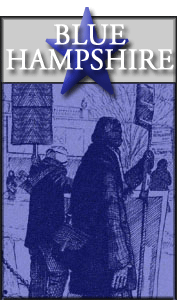|
First off, sample size. Five hundred fourteen total respondents to the poll gives an MoE of 4.3 percent, but they then threw out 44 of those responses to get a 'likely voter' universe of 472, with a high MoE of 4.5. They proceed to give the 'likely voter' and 'unlikely voter' breakdowns for favorability ratings, but not head-to-heads... but in their 'likely voter' universe, they still have nearly a quarter of their sample reporting that they are 'somewhat or not at all interested' in the election. Apparently "I'm not interested in the election" isn't a qualifying factor in being 'likely' to vote.
Second, age composition. Out of 466 'likely' respondents, 38 (only 8% of the sample) were in the 18-34 range - but out of 514 total respondents to the favorability question, 48 were in that age range, which was Hodes' most favorable age contingent (with, of course, the astronomical MoE that comes with a sample size of 38). By comparison, the 2004 elections had 13.9% of the electorate in the 18-29 range - six percent higher than the UNH estimate despite having 5 fewer years in that age range. Yeah, if the youth vote drops off by almost 50%, you see declining numbers for Democrats. And to compound the issue, UNH explicitly threw out over a fifth of their 'youth vote' from their likely voter model.
Third, medium. Telephone poll, no cell phones, worth 2 or 3 points of skew to the right already, as has been documented elsewhere.
Fourth, date range. September 23rd through September 29th? This poll was taken over that long a date range? That's huge. And that also says they got through under a hundred responses a day. How long was this poll? How many people did they call before they got their five hundred people willing to sit through the entire thing?
Fifth, partisan composition. I don't know if anyone's told UNH this, but Democrats passed Republicans in registration a few years back. If you have 22.5% Democrats and 28.5% Republicans in a state that actually shows a Democratic edge in registrations, your composition is skewed. In the 514 total respondents, they still had these numbers (3 more Republicans and 6 more Democrats), so it's not the likely voter screen accounting for the skewed sample.
Sixth, geography. According to this poll, more people in Representative Hodes' district know never-elected Kelly Ayotte than know him. The North Country loves them some Benson appointee. Manchester alone is providing a 2-1 margin.
Seventh, union membership. According to this survey, union membership has no impact on voting, despite all the elections before this one when it's had a significant lean.
Eighth, other recent polling. PPP had the race at 4; right-wing Ras had it at barely half the lead UNH is claiming; even the openly partisan ARG had a smaller lead than this is claiming. And back in 2008, let's not forget, UNH had Obama winning the NH presidential primary by 10, a miss by 13 points in a high-turnout affair, and at a similar point in the Senate race that year, had Jeanne Shaheen up by 4 in a race she eventually won by 10, and consistently had the lowest Shaheen lead of any pollster (save for a single bizarre Rasmussen poll).
Basically, the long and short of it is, this poll has some exceedingly large irregularities that make me doubt its utility. I can accept that, accounting for the oddities, yes, it probably does still show Ayotte ahead. But take about four points for the partisan composition, another 2 for missing cell-only voters, another 3 for being so off on the youth percentage and you might have something a little more like what you could reasonably expect to see on election day. And with that high uncertainty, at that point it's well within the MoE, same as Ras and PPP both reported in their last polls of this race.
|

